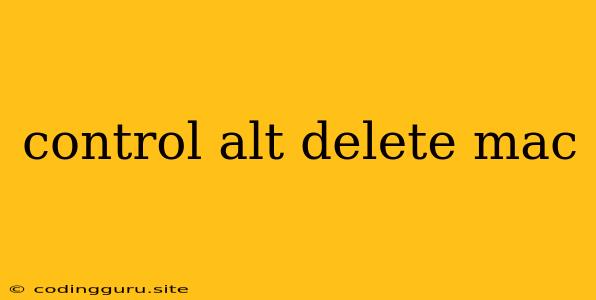Control Alt Delete: A Mac User's Guide
If you're a longtime Windows user, you're probably familiar with the infamous Control Alt Delete key combination. This powerful shortcut is used to access a variety of system functions, from restarting your computer to managing running applications. But what about Mac users? Do they have a similar shortcut?
The answer is not quite. Macs don't use the Control Alt Delete combination in the same way Windows does. Instead, Apple has its own set of keyboard shortcuts for similar functions.
Why the Difference?
The difference in approach stems from the inherent design philosophy of the two operating systems. Windows relies heavily on a traditional desktop metaphor, with windows and applications that can be manipulated and closed individually. Macs, on the other hand, emphasize a more streamlined and integrated approach, with a focus on app switching and minimizing background processes.
So, How Do I Force Quit or Restart My Mac?
Here's the good news: You don't need to worry about remembering a complicated combination of keys. There are several simple ways to access these common functions:
1. Force Quit an Application:
- Option + Command + Esc: This shortcut brings up the "Force Quit Applications" window, allowing you to select the unresponsive application and terminate it.
2. Restart Your Mac:
- Option + Command + Eject: This shortcut presents a dialogue box offering the choice to restart or shut down your Mac.
3. Shut Down Your Mac:
- Command + Option + Power: This shortcut brings up the shutdown confirmation dialogue.
4. Use the Apple Menu:
- Apple Menu > Shut Down... or Apple Menu > Restart...
5. Use the Menu Bar:
- Apple Menu > Force Quit... or Apple Menu > Restart...
What about the "Force Quit Applications" Window?
This handy window allows you to see all currently running applications. You can then choose to force quit any application that's unresponsive or behaving erratically.
To access this window:
- Option + Command + Esc
- Apple Menu > Force Quit...
- Menu Bar > Force Quit...
Alternative Solutions:
-
Activity Monitor: This built-in Mac application provides a more detailed overview of your system's performance and running processes. You can use it to force quit applications, monitor CPU and memory usage, and more.
-
Keyboard Shortcuts: Macs have numerous keyboard shortcuts for various tasks, including closing windows, switching between applications, and minimizing windows.
Tips for Avoiding the Need for Force Quitting:
- Keep your Mac's software up to date: Software updates often include bug fixes and performance improvements that can help prevent applications from crashing.
- Close unnecessary applications: The more applications running in the background, the more resources your computer has to dedicate. Closing these applications can improve overall performance and reduce the risk of crashes.
- Check for memory leaks: Some applications may have memory leaks that can cause them to become unstable. Monitor your Mac's memory usage to identify any potential issues.
- Restart your Mac regularly: This is a good practice to ensure all applications are running smoothly.
Conclusion
While Macs don't have a direct equivalent to Control Alt Delete, they provide a user-friendly approach to managing applications and restarting or shutting down your computer. Remember to use the Option + Command + Esc shortcut to force quit any problematic applications. Also, keep your Mac's software up-to-date and monitor its performance for any potential issues. By following these tips, you can ensure a smooth and efficient computing experience on your Mac.
